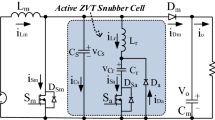Abstract
In this paper, a new snubber cell for soft switched high set-up DC–DC converters is introduced. The main switch is turned on by zero-voltage transition and turned off by zero-voltage switching (ZVS). The main diode is turned on by ZVS and turned off by zero-current switching. Besides, all auxiliary semiconductor devices are soft switched. Any semiconductor device does not expose the additional current or voltage stress. The new snubber transfers some of the circulation energy to the output side when it ensures soft switching for main semiconductor devices. Thus, the current stress of auxiliary switch is significantly reduced. Besides, the total efficiency of converter is high due to the direct power transfer feature of new converter. A theoretical and mathematical analysis of the new converter is presented, and also verified with experimental set-up at 500 W and 100 kHz. Finally, the overall efficiency of new converter is 97.4% at nominal output power.







Similar content being viewed by others
References
Zhu B, Ren L, Wu X and Song K 2017 ZVT high step-up DC–DC converter with a novel passive snubber cell. IET Power Electron. 10(5): 599–605
Zhang X, Qian W and Li Z 2017 Design and analysis of a novel ZVZCT boost converter with coupling effect. IEEE Trans. Power Electron. 32(12): 5992–9000
Yi J H, Choi W and Cho B H 2017 Zero-voltage-transition interleaved boost converter with an auxiliary coupled inductor. IEEE Trans. Power Electron. 32(8): 5917–5930
Ting N S 2018 A new high power factor ZVT–ZCT AC–DC boost converter. J. Electr. Eng. Technol. 13(4): 1538–1547
Akhlaghi B, Molavi N, Fekri M and Farzanehfard H 2018 High step-up interleaved ZVT converter with low voltage stress and automatic current sharing. IEEE Trans. Ind. Electron. 65(1): 291–299
Mohammadi M R and Farzanehfard H 2017 Family of soft-switching bidirectional converters with extended ZVS range. IEEE Trans. Ind. Electron. 64(9): 7000–7008
Ting N S, Aksoy I and Sahin Y 2017 ZVT-PWM DC–DC boost converter with active snubber cell. IET Power Electron. 10(2): 251–260
Sahin Y 2018 A novel soft switching PWM-PFC AC–DC boost converter. J. Electr. Eng. Technol. 13(1): 256–262
Ting N S, Sahin Y and Aksoy I 2017 Analysis, design, and implementation of a zero-voltage-transition interleaved boost converter. J. Power Electron. 17(1): 41–55
Sahin Y, Ting N S and Aksoy I 2018 A highly efficient ZVT–ZCT PWM boost converter with direct power transfer. Electr. Eng. 100(2): 1113–1123
Sahin Y and Ting N S 2018 Soft switching passive snubber cell for family of PWM DC–DC converters. Electr. Eng. 100(3): 1785–1796
Sahin Y, Ting N S and Acar F 2018 A soft switching with reduced voltage stress ZVT-PWM full-bridge converter. Rev. Sci. Instrum. 89(1): 1–9
Hua G, Leu C S, Jiang Y and Lee F C Y 1994 New zero-voltage transition PWM converters. IEEE Trans. Power Electron. 9(2): 213–219
Tarzamni T, Babaei E, Gharehkoushan A Z and Sabahi M 2017 Interleaved full ZVZCS DC–DC boost converter: analysis, design, reliability evaluations and experimental results. IET Power Electron. 10(7): 835–845
Das P and Moschopoulos G 2007 A comparative study of zero-current transition PWM converters. IEEE Trans. Ind. Electron. 54(3): 1319–1328
Adib E and Farzanehfard H 2012 Analysis and design of a zero-current switching forward converter with simple auxiliary circuit. IEEE Trans. Power Electron. 27(1): 144–150
Xi Y and Jain P 2003 A forward converter topology employing a resonant auxiliary circuit to achieve soft switching and power transformer resetting. IEEE Trans. Ind. Electron. 50(1): 132–140
Chao K H and Yang M S 2014 High step-up interleaved converter with soft-switching using a single auxiliary switch for a fuel cell system. IET Power Electron. 7(11): 2704–2716
Chen Y T, Shiu S M and Liang R H 2012 Analysis and design of a zero-voltage-switching and zero-current-switching interleaved boost converter. IEEE Trans. Power Electron. 27: 161–173
Adib E and Farzanehfard H 2008 Family of zero-current transition PWM converters. IEEE Trans. Ind. Electron. 55: 3055–3063
Rezvanyvardom M, Adib E, Farzanehfard H and Mohammadi M 2012 Analysis, design and implementation of zero-current transition interleaved boost converter. IET Power Electron. 5: 1804–1812
Lee D Y, Lee M K, Hyun D S and Choy I 2003 New zero-current-transition PWM DC/DC converters without current stress. IEEE Trans. Power Electron. 18: 95–104
Fuentes R C and Hey H L 1999 An improved ZCS-PWM commutation cell for IGBT’s application. IEEE Trans. Power Electron. 14: 939–948
Canesin C A and Barbi I 1997 Novel zero-current-switching PWM converters. IEEE Trans. Ind. Electron. 44: 372–381
Wang C M 2005 A new family of zero-current-switching (ZCS) PWM converters. IEEE Trans. Ind. Electron. 52: 1117–1125
Li Z, Zhang X, Qian W and Bai H 2016 A novel zero-current-transition PWM DC–DC converter with coupled inductor. In: Proceedings of the IEEE 7th International Symposium on Power Electronics for Distributed Generation Systems Conference, Vancouver, Canada, pp. 1–4
Urgun S 2011 Zero-voltage transition zero-current transition pulsewidth modulation DC–DC buck converter with zero-voltage switching zero-current switching auxiliary circuit. IET Power Electron. 5: 627–634
Rezvanyvardom M, Adib E and Farzenahfard H 2011 New interleaved zero-current switching pulse-width modulation boost converter with one auxiliary switch. IET Power Electron. 4(9): 979–983
Rezvanyvardom M, Adib E, Farzenahfard H and Mohammadi M 2012 Analysis, design and implementation of zero-current transition interleaved boost converter. IET Power Electron. 5(9): 1804–1812
Wai R J and Duan R Y 2005 High step-up converter with coupled-inductor. IEEE Trans. Power Electron. 20(5): 1025–1035
Wang C M, Lin C H, Lu C M and Li J C 2017 Analysis, design, and realisation of a ZVT interleaved boost dc/dc converter with single ZVT auxiliary circuit. IET Power Electron. 10: 1–11
Lee J H 2013 Auxiliary switch control of a bidirectional soft-switching DC/DC converter. IEEE Trans. Power Electron. 28(12): 5446–5457
Author information
Authors and Affiliations
Corresponding author
Rights and permissions
About this article
Cite this article
Sahin, Y., Ting, N.S. Design, analysis and application of high set-up ZVT DC–DC converter with direct power transfer. Sādhanā 43, 169 (2018). https://doi.org/10.1007/s12046-018-0938-3
Received:
Revised:
Accepted:
Published:
DOI: https://doi.org/10.1007/s12046-018-0938-3




